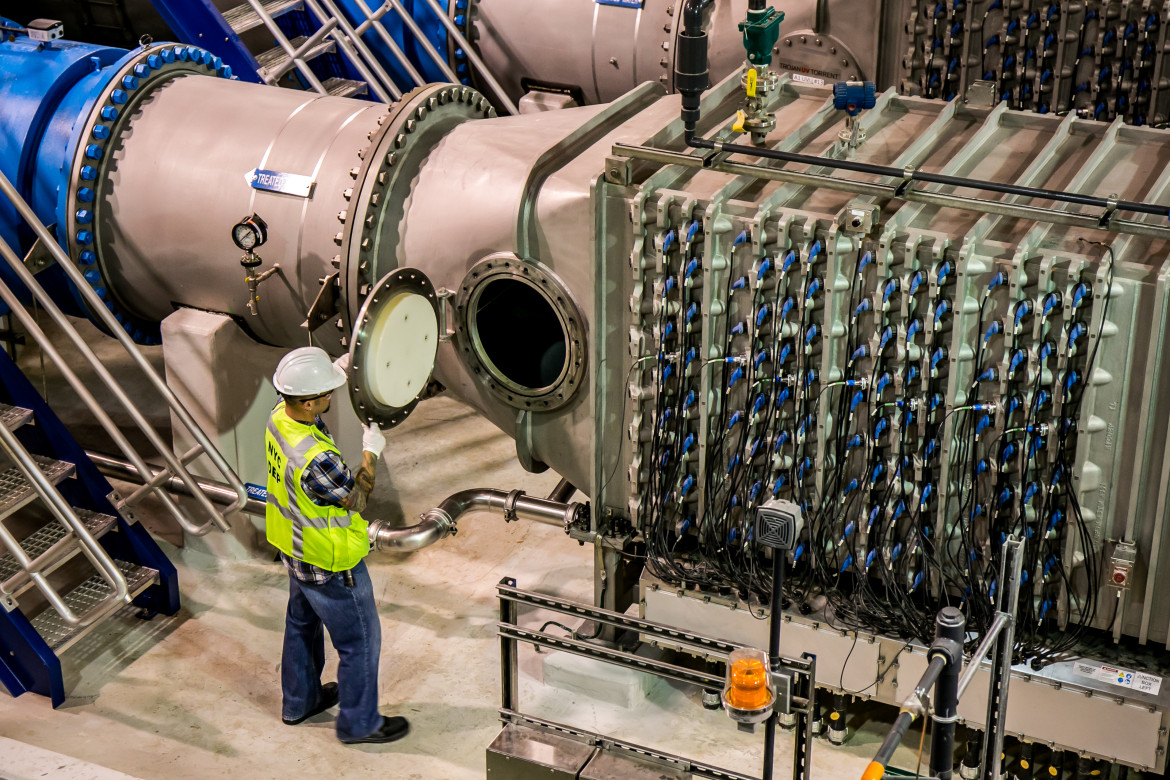In the water purification or treatment process, primary filtration is a critical stage that ensures the effectiveness and efficiency of the entire system. However, in our 17 years of experience, we have seen that not having a good design or operation can lead to high operating and maintenance costs and inadequate water quality. 7 mistakes to avoid when designing a filtration system
In this article, we will focus on the seven most common mistakes in primary filtration and how to prevent them from ensuring the proper functioning of the water treatment system.
1. Miscalculation of flow rate and filter media backwash cycles.
Excess or insufficient backwash flow in gravity or pressurized filters is a recurring problem in many water treatment plants. When excess flow occurs, filter media can be lost through the upper troughs or manifolds, resulting in unnecessary water and energy expended in backwashing, as well as modification of the design height of the filter bed. 7 mistakes to avoid when designing a filtration system
Conversely, the insufficient flow does not allow for adequate expansion of the filter bed, leading to poor backwashing and, thus, a greater total volume of water required to remove all the accumulated suspended solids. This can gradually accumulate suspended solids, leading to solids carryover problems and filter media clogging.
This problem can also cause severe problems during filter start-up. Not having the correct expansion flow causes excessive time and water expenditure in removing all the fines added to the filter media.
To avoid this problem, it is essential to know the expansion curves of the filter media to be installed and to correctly calculate the backwash pumping system, especially if an air expansion system is being considered. In turn, if the filtering system is located in areas with drastic changes in water temperature, it is necessary to modify the flow according to the year’s season since the bed’s expansion depends on this.

A good filter media supplier should provide detailed information on their products’ bed expansion curves and backwashing capacity (Figure 1). However, not all filter media have the same bed expansion capacity, so it is important to know this information to calculate the backwash pumping system correctly. In addition, it is recommended that the backwashing curve of the filter bed has a steeper slope to reduce water and energy consumption in each cycle.
Backwash system misconfiguration or backwash system failure
Misconfiguration of the backwash operation cycle is an error that can have serious consequences in the operation and maintenance of a filtration plant. Occasionally, situations arise where the filter does not register the required minimum pressure drop (10 PSI) to initiate the backwashing process, which can be attributed to different reasons, such as low solids loading in the feed water or malfunction of the automatic backwashing system. 7 mistakes to avoid when designing a filtration system
If the filter is not properly backwashed and left to operate for several days, the bed can become compacted, and the water flow can form channels within the filter media. This lack of maintenance can eventually lead to the filter media’s petrification, reduced filtration efficiency, increased water and energy consumption in backwashing, or imminent media replacement (Figure 2).

To avoid problems of compaction and petrification of the filter media, it is important to ensure that the filter is backwashed, even if there is no established pressure drop.
The American Water Works Association states that the filter backwash cycle should be performed every 48 hours at the latest to ensure proper operation. However, our experience has allowed us to verify that in some cases, using Zeomedia filter media, the backwash cycle can be extended up to 72 hours without major problems.
Nevertheless, it is advisable to closely monitor the condition of the filter to detect any irregularities and take preventive measures in time.
Download free your ebook in PDF and read it everywhere

2. System feed with solids and contaminants load over its handling capacity. 7 mistakes to avoid when designing a filtration system
The solids holding capacity of a filter depends on the filter media’s physicochemical characteristics and the bed’s hydraulic retention time. This capacity may vary according to the size and nature of the solids, the desired filtered water quality, and the maximum amount of solids to be admitted.
It is important to consider these factors when selecting the appropriate filter media and to ensure efficient filtration. In general, solids holding capacity can range from 65% to 75% for sand beds and 90-95% for filter media such as Zeomedia, with a retention time of approximately 8 to 10 minutes. Generally, it is recommended not to exceed the suspended solids limits to maintain the filtered water quality within the required specifications.
It is advisable not to exceed 15 ppm of suspended solids for drinking water treatment plants, while for reverse osmosis systems, the limit is 5 ppm. Otherwise, problems may occur, such as:
- Poor output water quality: If suspended solids limits are exceeded, the filtered water will likely not meet the required quality standards. This can be especially critical in potabilization or industrial water production processes.
- Saturation and clogging of the filter bed: Excess suspended solids can saturate the filter media and reduce its capacity to retain particles. In addition, it can cause clogging of the filter media pores, impeding the flow of water and decreasing the efficiency of the filtration process.
- Increased backwash cycles: When suspended solids limits are exceeded, the frequency of backwashes required to maintain the efficiency of the filtration process increases. This implies higher water and energy consumption, which increases the system’s operating costs.
- Damage to filtration equipment: The presence of suspended solids can cause damage to filtration equipment, such as pumps and valves, which can result in costly repairs and maintenance.
Therefore, it is important to constantly monitor the levels of suspended solids in the filtered water and take measures to prevent them from exceeding the recommended limits. This includes implementing sedimentation or clarification systems before the filtration process, properly selecting filter media, and optimizing backwash cycles.
Maintaining the efficiency of the filtration process is critical to ensure treated water quality and reduce system operating costs.

3. The internal diffuser system is not properly designed or is damaged, resulting in inadequate flow distribution.
This problem frequently occurs in gravity or horizontal filters with a diameter greater than 72 inches. This is because when the fluid distribution system is not properly designed, there is a phenomenon of differential flows and channeling where one part of the filter bed processes more fluid than another, causing poor filtration.

In addition, if the internal collector system is poorly designed, there can be a problem known as “bad distribution,” where the backwash flow is not evenly distributed, resulting in poor filter bed flushing.
This problem can also occur when the filter’s lower collectors (crepins) are broken or damaged, resulting in uneven flow in the filter bed. In the long term, this problem can lead to increased buildup in a specific part of the filter bed, suspended solids carryover, and poor filtration.
For more information on designing a proper backwash system, please refer to (Beverly, R. (2011). Filter Troubleshooting and Design Handbook. American Water Works Association) or refer to the following article: https://zeomediafilter.com/en/granular-filter-media/.
4. The filtration presents problems of hydraulic imbalance in the flow system. 7 mistakes to avoid when designing a filtration system
When implementing a filtration train with more than 4 filters in series, installing flow control valves on each filter is crucial to ensure an even water flow distribution throughout the train. If this is not done, the water flow will tend to be directed first to the filters closest to the feed pump, resulting in a higher filtrate flow rate than the filters farther away (Figure 4).
This can result in poor filtrate quality and excessive water wastage in the filters closer to the pump, while the filters farther away will be underutilized.
In some cases, we have observed that filters closer to the pump may filter almost twice as much as filters farther away.

To solve this problem, when designing filter systems of more than 4 in series, flow control valves must be installed on each filter to ensure even feed flow distribution throughout the filtration train. In this way, the water flow rate in each filter can be controlled and ensure that the distribution is uniform.
In addition, it is important to consider the filters’ physical location and the piping length connecting each filter to the feed pump. The goal is to reduce system pressure differentials and head loss by achieving proper flow distribution.
It is also possible to use a T- or Y-flow distribution system, where the feed flow is divided into equal parts and directed to each filter evenly. This solution is especially useful when high filtration capacity is required, and several filters are available in parallel.
5. The height of the filter bed is not correctly dimensioned about the height of the filter tank.
One of the common problems in filter media installation is the lack of consideration of filter bed height about filter height.

In the case of filling the filter media tanks above the design height of the filter without leaving an expansion margin of at least 30% (ideally 50%), it can cause the loss of filter media through the collectors or the accumulation of solids in the filter bed, which would prevent its adequate backwashing.
These problems can lead to decreased filtrate quality and the need to replace the filter media ahead of schedule, which implies an additional cost.
On the other hand, leaving insufficient height in the filter bed (less than 70 cm, ideally 1 m) may cause carryover or leakage of suspended solids during filter operation, resulting in poor filtration. To avoid these situations, it is recommended to leave a clearance between the upper collectors and the filter bed of at least 50% of the total height of the filter bed.

In summary, the height of the filter bed is a key factor in the design and installation of filter media in water treatment. It is important to follow recommendations and good practices to avoid filtration problems and prolong the life of the filter media.
6. It does not have adequate pretreatment before the filtration process.
Designing a water purification or treatment plant is not a simple task; it requires a reliable design basis and sufficient information on the characteristics of the water to be treated. One of the most important studies is the characterization of the water, which is carried out through a sampling and analysis campaign that allows knowing the minimum, maximum, and average concentrations of the different contaminants present in the water.
Among the most important parameters for designing a filtration system are turbidity, suspended solids, particle size and frequency, BOD or organic matter, and the presence of fats and oils. It is essential to consider the presence of these contaminants in the water, as they can cause different problems during the filtration process.
Suppose organic matter is present in the water to be treated, and a disinfection pretreatment is not installed. In that case, biological growth problems can be generated in the filters, contributing more contaminants to the effluent instead of removing them. In addition, fats, oils, and grease can cause clogging and agglomeration of the filter media, reducing its capacity to retain contaminants.
Therefore, it is essential to have detailed information on the characteristics of the water to be treated and to consider all of the above parameters when designing a filtration system or water treatment plant. In this way, it will be possible to guarantee an effective filtration process and suitable water quality.
Table 1 Problems and solution of the most significant parameters for filtration
| Parameter | Problem | Solution |
| Turbidity | Filter media clogging and poor filtration | Installation of a sedimentation or coagulation pretreatment system |
| Suspended solids | Filter media clogging and efficiency reduction | Installation of a sedimentation or flotation pretreatment system |
| Particle size and frequency | Inadequate selection of filter media and poor filtration | Selection of the appropriate filter media according to pore opening |
| BOD or organic matter | Biological growth in filters without disinfection pretreatment | Chlorination or ozonation pretreatment installation |
| Fats and oils | Clogging and agglomeration of the filter media | Installation of a grease and oil separation pretreatment plant |

7. It does not have filtering material of adequate quality or characteristics.
The filter media is a crucial element in any filtration system. Its quality and characteristics directly affect the performance and efficiency of the filter. However, there are common problems that can compromise its performance and filtered water quality.
One of the most frequent problems is the prolonged use of the filter media without change. This can cause the media grain size to become smaller and more uniform, resulting in better retention of suspended solids. Still, it also accelerates media clogging, resulting in shorter operating cycles and excessive water and energy consumption in backwashing.
Therefore, changing the filter media at least every five years is important.
Another problem is the contamination of the filter media with heavy metals. This can occur when low-quality filter media are selected that contain several contaminants and added inert materials that are released during backwashing and filter operation, contaminating the water and other elements of the filtration system.
To avoid this, it is recommended to use NSF ANSI 61 certified filter media, which guarantees an acid solubility percentage of no more than 5%.
In addition, the uniformity coefficient of the filter media is important as it is used to determine the uniformity between the particle size of a sample. In the case of filter media, it is recommended that this coefficient should not be greater than 1.6.
Otherwise, the filter media will stratify during backwashing, leaving the smallest grains at the top. This causes a significant decrease in the operating cycle to retain the particles in suspension, resulting in poor filtration.
On the other hand, it must be taken into account that the larger the particle size of the filter media, the lower the efficiency of the removal of suspended solids. Still, it will be able to give a greater filtration performance.
To learn more about evaluating the quality of the filter media, it is recommended to consult the ANSI/AWWA B100-89 standard of the American Work Association.
Conclusions of 7 mistakes to avoid when designing a filtration system
In conclusion, a well-designed and properly commissioned granular filtration system can provide excellent water quality at a reasonable cost. However, it is important to avoid common system design and commissioning mistakes to achieve optimum performance. 7 mistakes to avoid when designing a filtration system
Selecting the right filter media and changing it regularly is essential to avoid clogging the system. In addition, the water quality and characteristics of the feed water should be considered to determine the necessary treatments.
It is important to avoid using low-quality filter media that may release contaminants into the water. Regular cleaning and maintenance of the system are also crucial to maintain efficient performance and prolong the system’s life.
In summary, careful design, proper commissioning, and regular maintenance are key to ensuring the optimum performance of a granular filtration system.
Bibliography
- ANSI/AWWA B100-89 American Work Association.
- Beverly, R. (2011). Filter Troubleshooting and Design Handbook. American Water Works Association.
- Tchobanoglous, G., Burton, F. L., & Stensel, H. D. (2003). Wastewater engineering: treatment and reuse (4th ed.). McGraw-Hill.
- APA format: Tchobanoglous, G., Burton, F. L., & Stensel, H. D. (2003). Wastewater engineering: treatment and reuse (4th ed.). McGraw-Hill.
- AWWA. (2017). Water treatment plant design (5th ed.). McGraw-Hill Education.
- Metcalf & Eddy, Inc. (2014). Wastewater engineering: treatment and resource recovery (5th ed.). McGraw-Hill Education.
- WHO. (2011). Guidelines for drinking-water quality (4th ed.). World Health Organization.
- Watten, B. J. (2016). Filter bed hydraulics and filter ripening. Water treatment plant design, fifth edition: American Society of Civil Engineer
- Zhong, L., Liu, Y., Li, J., & Zhang, J. (2019). A review on granular media filtration. Water, 11(5), 956.





